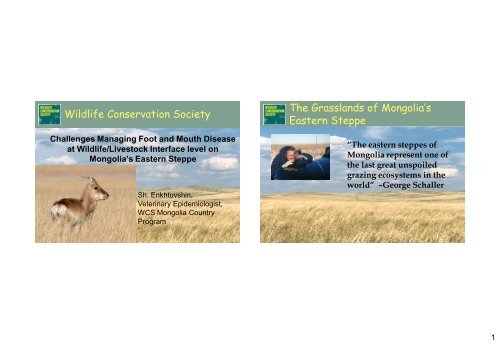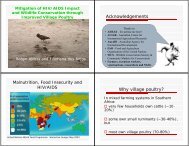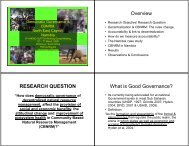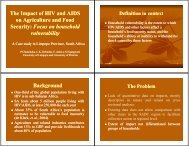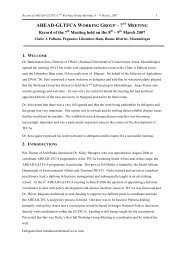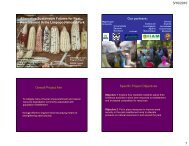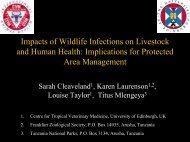Challenges Managing Foot and Mouth Disease (FMD) at the Wildlife ...
Challenges Managing Foot and Mouth Disease (FMD) at the Wildlife ...
Challenges Managing Foot and Mouth Disease (FMD) at the Wildlife ...
You also want an ePaper? Increase the reach of your titles
YUMPU automatically turns print PDFs into web optimized ePapers that Google loves.
<strong>Wildlife</strong> Conserv<strong>at</strong>ion Society<strong>Challenges</strong> <strong>Managing</strong> <strong>Foot</strong> <strong>and</strong> <strong>Mouth</strong> <strong>Disease</strong><strong>at</strong> <strong>Wildlife</strong>/Livestock Interface level onMongolia's Eastern SteppeSh. Enkhtuvshin,Veterinary Epidemiologist,WCS Mongolia CountryProgramThe Grassl<strong>and</strong>s of Mongolia’sEastern Steppe“The eastern steppes ofMongolia represent one of<strong>the</strong> last gre<strong>at</strong> unspoiledgrazing ecosystems in <strong>the</strong>world” –George Schaller1
Mongolia’s Eastern SteppeEastern Steppe250,000 km 2 Serengeti25,000 km 22
Mongolian Gazelle(Procapra gutturosa)Mongolian Gazelle• Popul<strong>at</strong>ionDecline– 18 million?– 1994: 2.67million– 2005: 1.13million• Range Reduction– 1.1 million km 2 (1950) to 435,000 km 2 (2000)3
Mongolian Gazelle: CurrentSt<strong>at</strong>us• Popul<strong>at</strong>ion Estim<strong>at</strong>es– 1.13 million (+/-250,000)• Popul<strong>at</strong>ion Density– 15 gazelle/km 2• Range– Individual gazelle rangesover 25,000 km 2Mongolian Gazelle: Popul<strong>at</strong>ionDynamics• Nomadic “UnpredictableDistribution”• Extreme sp<strong>at</strong>iotemporalvariability in foodavailability (stochasticrainfall events)• Large arearequirements for range4
Conserv<strong>at</strong>ion <strong>Challenges</strong>Rangel<strong>and</strong> Resources & PastureDegrad<strong>at</strong>ion• Grassl<strong>and</strong>competition withlivestock• Pastureovergrazing• Clim<strong>at</strong>e Change– Drying of <strong>the</strong>steppe• L<strong>and</strong> developmentoil extraction <strong>and</strong>mining5
Number of provinces<strong>Disease</strong> issues• <strong>Disease</strong> <strong>at</strong> <strong>the</strong>interface of wildlife<strong>and</strong> livestock is anemerging issue– Example of <strong>Foot</strong> &<strong>Mouth</strong> <strong>Disease</strong> (<strong>FMD</strong>)– <strong>FMD</strong> consultantDr. Gavin Thomson’svisit from SouthAfrica22181052<strong>FMD</strong> outbreaks in Mongoliahistorically <strong>and</strong> recentlyOFFICIALLY RECORDED OUTBREAKS OF <strong>FMD</strong> IN MONGOLIA1937-1947 1964-1974 2000 – 20106
Recent <strong>FMD</strong> outbreaks in MongoliaEURO-SAME-SA0.02SEAC<strong>at</strong>hayUKG/10/2001 (AJ311722)O/JPN/2000 (AB050978)O/Mongolia/2000O/Mongolia/2001O/CHA/2/99 (AJ318831)O/Russia/2000O/Mongolia/2002O/Russia/2004O/Tajikistan/2003O/Tajikistan/2001O/Tajikistan/2002O/AFG/201/2004 (EF457985)O/ISR/7/2007 (FJ561315)O/JOR/6/2006 (FJ561317)O/Kazakhstan/1/2007O/PAK/10/2006 (EF494503)O1/Manisa/Turkey/69 (AJ251477)O/HLJOC12/CHA/03 (DQ119643)O/Mongolia/2004O/MYA/2/2000 (DQ164927)O/LAO/2/2001 (EU667445)O/MYA/7/2002 (DQ164928)O/VN/SL192/2009 (HM055508)O/VN/QN133/2009 (GU582121)O/Mongolia/CO3/2010-C<strong>at</strong>tle KhalhgolO/Mongolia/C05/2010-C<strong>at</strong>tle KhalhgolTAW/81/97 AJ296321O/Russia/1995O/HKN/12/91 (AJ294921)O/PHI/5/95 (DQ164946)O/Corrientes/Arg/06 (DQ834727)O1/BFS (J02185)Fig. Neighbor-joining tree showing <strong>the</strong> position of <strong>FMD</strong>V O/Mongolia/2010 field isol<strong>at</strong>es. Based on complete VP1 sequences.7
<strong>Disease</strong> issues:<strong>FMD</strong> control <strong>and</strong> prevention• Cre<strong>at</strong>ion of Control zoneThis includes outbreak zone, buffer zone, vaccin<strong>at</strong>ion zone, <strong>and</strong>healthy zone• Quarantine <strong>and</strong> disinfection activitiesQuarantine <strong>and</strong> disinfection of livestock, livestock products,human <strong>and</strong> traffic movements <strong>and</strong> disinfection of livestockpremises• Modified stamping outModified stamping out of clinically ill livestock <strong>and</strong> gazelles asof 2010 experience. The compens<strong>at</strong>ion for stamping out iscalcul<strong>at</strong>ed to equal 90% of <strong>the</strong> livestock market price• Ring vaccin<strong>at</strong>ion: Vaccin<strong>at</strong>ion of high risk or outbreak areasfrom government without any fees<strong>FMD</strong> control activitiesTotal number of livestock <strong>and</strong> wildlife destroyedduring 2010 <strong>FMD</strong> outbreaksYear Species Number Destroyed2010 C<strong>at</strong>tle 6,7302010 Sheep 13,4952010 Go<strong>at</strong>s 5,6982010 Camels 102010 Gazelles 1,616Total 27,5498
WCS <strong>FMD</strong> serosurveillance studysummary in Gazelles1998-99 Found no evidence of <strong>FMD</strong> infection inpopul<strong>at</strong>ion of 78 adult gazelles2001 <strong>FMD</strong>V-NS was detected in 67% out of 33adult gazelles2005-07 <strong>FMD</strong>V-NS was detected in 10.9% out of57 gazelle calves (m<strong>at</strong>ernal immunity)2008 Found no evidence of <strong>FMD</strong> in popul<strong>at</strong>ion of36 adult gazelles<strong>FMD</strong> outbreaks in Gazelles in 2010The St<strong>at</strong>e Central Veterinary Labor<strong>at</strong>ory detectedfollowing infections in Gazelles: <strong>FMD</strong>V gene from 8 (57.1%) samples out of 14 gazelles <strong>and</strong><strong>FMD</strong>V antibody from 11 serum out of 14 gazelle samplescollected from Eastern Steppe. 32 serum samples were positive with <strong>FMD</strong>V –NS antibodyELISA out of 62 serum samples collected from EasternSteppe.9
<strong>FMD</strong> outbreaks in GazellesWh<strong>at</strong> is <strong>the</strong> <strong>FMD</strong> conclusionGazelles were detected with <strong>FMD</strong> clinical signs such as lameness,weight loss, fallen hoof. Gazelles are suspected for <strong>the</strong> spread of<strong>FMD</strong> in livestock (since 2001, 2004 & 2010) <strong>the</strong>refore, a selectivecull of clinically ill gazelles was ordered. A total of 1,616 Mongoliangazelle were destroyed on <strong>the</strong> Eastern Steppe.• <strong>FMD</strong> outbreaks have:– usually been extensions of livestock-associ<strong>at</strong>ed Asianp<strong>and</strong>emics (e.g. 2000/1/2; 2005; 2010)– These viruses did not persist in Mongolia <strong>the</strong>refore,<strong>FMD</strong> is not endemic– Mongolia has an <strong>FMD</strong> high-risk area Eastern Steppebordering with China <strong>and</strong> Russia (primary outbreaksdetected 50-100 km from borders)10
Wh<strong>at</strong> is <strong>the</strong> <strong>FMD</strong> conclusion• Once <strong>FMD</strong> occurs on eastern Steppe, do gazellescontribute to spread of <strong>the</strong> infection?– answer unknown– pending fur<strong>the</strong>r investig<strong>at</strong>ion needed, but should beassumed <strong>the</strong>y spread <strong>the</strong> infection– but, <strong>the</strong>y are likely to be less effective spreadersthan c<strong>at</strong>tle or o<strong>the</strong>r livestock• The issue of ‘carriers’ (for both livestock & gazelles) ismisunderstood in Mongolia <strong>and</strong> <strong>the</strong>refore modifiedstamping out is a major part of <strong>the</strong> <strong>FMD</strong> control activityWCS Activities• Provide governmentorganiz<strong>at</strong>ions with correct <strong>FMD</strong>epidemiology inform<strong>at</strong>ion <strong>and</strong>recommend<strong>at</strong>ions for future<strong>FMD</strong> control <strong>and</strong> preventionactivities <strong>and</strong> policies• Promote <strong>the</strong> adoption of <strong>FMD</strong>control activities to supportwildlife conserv<strong>at</strong>ion• Promote high level of livestockherd immunity <strong>at</strong> <strong>FMD</strong> high riskareas• Cross pollin<strong>at</strong>ion withapproaches from intern<strong>at</strong>ionalAHEAD/SCAPES <strong>and</strong> o<strong>the</strong>rhealth programs11
Collabor<strong>at</strong>ion with Environmentalorganiz<strong>at</strong>ions• L<strong>and</strong>scape-LevelConserv<strong>at</strong>ion Planning• Intern<strong>at</strong>ionalConserv<strong>at</strong>ion Policydevelopment• Development ofCommunity-BasedN<strong>at</strong>ural ResourceManagement• Transboundaryconserv<strong>at</strong>ion activitiesCollabor<strong>at</strong>ion with Veterinary Agencies• Long term diseasesurveillance studies inlivestock <strong>and</strong> wildlife suchas Mongolian gazelles• Environmentally friendlydisease control <strong>and</strong>prevention activitiesfavoring wildlifeconserv<strong>at</strong>ion12
Thank You for Your Attention!Acknowledgements• USAID• AHEAD• TAD Scientific13


